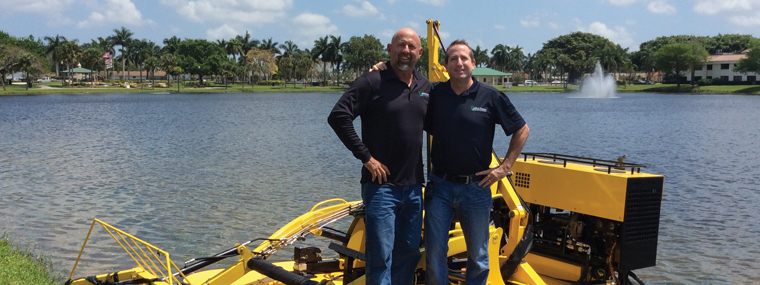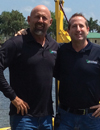
Association Boards Must Maintain Lakes and Waterways:
Just Like Other Amenities
By Stuart Fischer and Brian Fischer / Published October 2016

One of the most common images of living in Florida is that of a tranquil lake teeming with fish, birds dotting the view, and beautiful native foliage along the shoreline. It certainly makes for an enviable lifestyle, but just as important is the value waterfront living brings to residents and condomin-ium and homeowners associations. Make no mistake that these properties are at a premium since there is limited availability. It is certainly reflected by the price. One study reports that the national median price for a waterfront single-family home is more than $370,000, while a “dry” single-family home is $170,000.
Home buyers are willing to pay a premium for this amenity, just as they are willing to pay for access to clubhouses, golf courses, and swimming pools. The key issue is that all amenities must be maintained in such a way as to improve property values and satisfy the lifestyle needs of homeowners.
This is true whether it’s re-surfacing a swimming pool, replacing a clubhouse roof, or caring for the lakes and waterways within a community association. Years of neglect can result in huge costs for associations. Consequently, boards of associations must regard waterways and lakes as assets that must be maintained and monitored so they meet lifestyle and environmental standards. Board members must also recognize that, just like a swimming pool, lakes are centers of recreation, providing opportunities for boating, fishing, and photography.
All of that said, there are certain issues that board members must be aware of regarding lakes as they strive to govern their association communities efficiently. Following is an overview of some of these issues.
Retention Ponds:The vast majority of lakes in Florida weren’t actually in existence before a developer began preparing a property for construction. Lakes are created as “retention” areas that allow heavy amounts of rain to flow into the lake to prevent flooding. They are typically very shallow, ranging in depth from 4–15 feet. In addition, with the creation of these retention ponds comes the creation of waterfront lots, which adds to the value of the homes and the perception of quality for the community.
Like Maintaining a Fish Tank: Since these lakes are artificially created, boards should realize that caring for them is much like maintaining a fish tank. An ecological balance must be maintained through a variety of measures resulting in healthy water, a safe environment for wildlife, appropriate vegetation, and the elimination of damaging algae, to name a few.
Fountains Aren’t Just for Looks:Many of us drive through communities and certainly notice large fountains spraying plumes of water. At night they are frequently highlighted by colored lights and are pretty, but they are much more than ornamental features. They are an important part of creating a sound, healthy environment for fish since they aerate lakes, creating a healthy place for fish to multiply and thrive. In addition, fish are important as they can eliminate and control midge and mosquito populations. Part of maintaining a lake is stocking it with these types of fish, which is no different than placing a snail in a fish tank to clear surfaces.
Plantings for Aesthetics, Nutrients, Wildlife, Shoreline Preservation: There’s nothing quite like looking out on a lake and seeing foliage on shorelines and thriving wildlife. Well, it’s important to know that while some aquatic plants are beautiful, they may be harming the environment, polluting the water, and damaging the habitat for birds, fish, and other wildlife. It’s important to identify these harmful plantings, remove them, and replace them with aquatic plants that actually improve the environment. For example, appropriate plantings must provide nutrients for the water, thereby providing a healthy place for fish. They should attract wildlife seeking places for nesting and multiplying, and these plants must also offer a food source. Plantings are also important in preventing erosion along the shorelines. Keep in mind that the water levels of these lakes fluctuate greatly between the dry and wet seasons in Florida. This fluctuation can frequently be violent because heavy storms—and at times, hurricanes—can quickly de-stabilize shorelines. Proper plantings can maintain shorelines, ensuring that the lakes can act as efficient retention ponds that prevent flooding.
Beware the Growing Season: Boards should also be aware of the problems associated with Florida’s growing season. Healthy, nutrient-producing plants as well as damaging aquatic growth and algae thrive during the summer. They can be managed by environmentally safe sprays. In many cases, plants must be removed manually. Mechanical Shoreline Restoration: These retention ponds and lakes are subject to drastic weather changes resulting from dry and wet seasons. These result in grass and algae decomposing and collecting on lake bottoms. The rise and fall of water levels also takes its toll on shorelines, causing erosion. This work often requires sophisticated equipment and strategies that remove sediment and restore shorelines. These are related programs which are done in one efficient phase. One of the most efficient systems is the installation of Shoresox™, an all-in-one solution that is ideal for the unique plight of Florida’s eroding shorelines. It is both cost- and time-effective.
Lakes and waterways in association communities are certainly an important and beautiful amenity, providing scenic views and many activities. Most boards and residents aren’t aware of a problem until dead fish wash up on shores, algae create odors, or flood waters approach waterfront homes. Ongoing and preventive maintenance of association “aquariums” is the key to maintaining budgets and ensuring that the association’s liquid assets are properly managed so that property values are enhanced.
Stuart and Brian Fischer
Presidents of Lake and Wetland Management Inc.
Stuart Fischer and Brian Fischer are Presidents of Lake and Wetland Management Inc. (www.lakeandwetland.com). Founded in 1992, Lake and Wetland Management is a full-service environmental resource management company. Its state-certified, trained biologists have been providing environmental services for waterways, wetland management, lake management, and natural areas throughout Florida, leading the industry of environmental services. The firm works closely with many government agencies, builders, developers, community association managers, and homeowners associations. Based in Boynton Beach, Florida, Lake and Wetland Management has 14 offices throughout the state.




